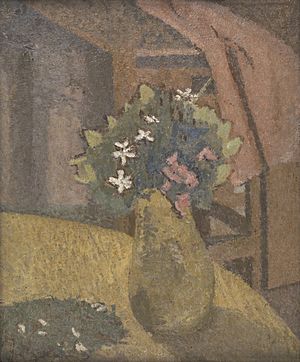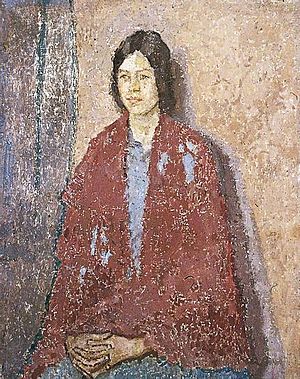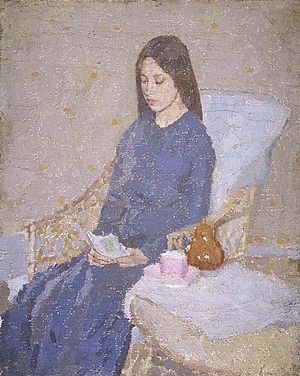Gwen John facts for kids
Quick facts for kids
Gwen John
|
|
|---|---|

Self-Portrait (1902)
|
|
| Born |
Gwendolen Mary John
22 June 1876 |
| Died | 18 September 1939 (aged 63) Dieppe, France
|
| Nationality | Welsh |
| Education | Slade School of Art Académie Carmen |
| Known for | Portraiture, still life |
| Patron(s) | John Quinn |
Gwendolen Mary John (born June 22, 1876 – died September 18, 1939) was a talented Welsh artist. She spent most of her career living and working in France. Gwen John was known for her paintings, especially portraits of women. These paintings often used similar shades of color.
During her lifetime, her brother, Augustus John, and her friend, Auguste Rodin, were more famous. However, after her death, Gwen John's art became much more recognized and admired.
Contents
Early Life in Wales
Gwen John was born in Haverfordwest, Wales. She was the second of four children. Her parents were Edwin William John and Augusta (née Smith). Her older brother was Thornton, and her younger siblings were Augustus and Winifred.
Her father, Edwin, was a serious lawyer. Her mother, Augusta, was often sick. This meant her two aunts, who were strict members of The Salvation Army, helped raise the children. Augusta was also an amateur watercolor painter. Both parents encouraged their children to enjoy reading and art.
Gwen's mother died when Gwen was only eight years old. Her brother, Augustus, later wrote that their mother would have been very helpful. He said she had a sad life before she passed away.
After their mother's death in 1884, the family moved to Tenby in Pembrokeshire, Wales. Gwen and her sister Winifred were taught by private teachers at home. The sisters often went to the coast in Tenby to draw. Gwen loved to sketch quickly. She drew seagulls, shells, and fish on any paper she could find. Even though she drew from a young age, her oldest surviving artwork is from when she was nineteen.
Art Education and Training
From 1895 to 1898, Gwen John studied art at the Slade School of Art in London. This school taught art like French art studios. It was the only art school in the United Kingdom that allowed female students. However, men and women were usually kept separate in classes and hallways.
Gwen studied drawing figures with Henry Tonks. Her younger brother, Augustus, also studied there. Gwen and Augustus lived together to save money. They ate simple meals like nuts and fruit. Gwen became close friends with Ida Nettleship, who later married Augustus. She also had a relationship with Arthur Ambrose McEvoy, another friend of her brother's. This relationship was not a happy one. Gwen also became good friends with Ursula Tyrwhitt and Gwen Salmond. In her last year at Slade, Gwen won an important art prize.
Students at Slade were encouraged to copy famous old paintings in London museums. Gwen's early paintings, like Portrait of Mrs. Atkinson, show a traditional style. They use soft colors and thin layers of paint.
Even as a student, Augustus was very famous for his drawing skills and charming personality. This was different from Gwen, who was quieter and more reserved. Augustus admired his sister's work. He worried she didn't take care of herself and told her to be more active. Gwen did not follow his advice and often ignored her own health.
In 1898, Gwen visited Paris for the first time with two friends from Slade. There, she studied with James Abbott McNeill Whistler at his school, Académie Carmen. She returned to London in 1899. In 1900, she showed her work for the first time at the New English Art Club.
Life and Art in France
In late 1903, Gwen traveled to France with her friend Dorelia McNeill. Dorelia later became Augustus John's second wife. They planned to walk all the way to Rome, carrying their art supplies. They slept in fields and earned money by selling quick portrait sketches. They only made it as far as Toulouse.
In 1904, Gwen and Dorelia went to Paris. Gwen found work as an artist's model, mostly for women artists. That same year, she started modeling for the famous sculptor Auguste Rodin. She became his friend and admirer. Rodin even used Gwen as a model for a sculpture. Gwen was very devoted to Rodin for ten years. She wrote him thousands of letters. Rodin was much older than her and very famous. Gwen sometimes became very attached to people, which could be difficult for them. Rodin eventually had to use his assistants to keep her at a distance.
During her time in Paris, Gwen met many important artists. These included Henri Matisse, Pablo Picasso, and Constantin Brâncuși. However, new art styles did not change her own work much. She preferred to work alone. In 1910, she moved to Meudon, a suburb of Paris. She lived there for the rest of her life.
As her friendship with Rodin ended, Gwen found comfort in Catholicism. Around 1913, she joined the Catholic Church. Her notebooks from this time show her thoughts and prayers. She wrote that she wanted to be "God's little artist" and to "become a saint." In a letter from around 1912, she wrote that she might never have anything to express, except a wish for a deeper, more private life.
Developing Her Art Career
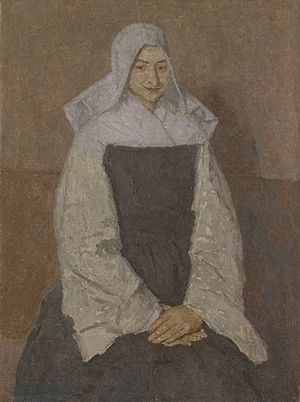
Gwen stopped showing her art at the New English Art Club in 1911. However, she found an important supporter named John Quinn. He was an American art collector. From 1910 until his death in 1924, Quinn bought most of the art Gwen sold. His support meant Gwen no longer had to work as a model. She could focus completely on her painting.
Even though she showed her art regularly, Gwen was very particular about exhibiting. She wrote in 1911 that she painted a lot but rarely finished a picture. She said finishing a painting needed a long time of quiet thought and never thinking about exhibitions. In 1913, one of her paintings was shown in a very important art exhibition in New York called the Armory Show. John Quinn helped organize this show.
Gwen had a humble but confident view of her own work. After seeing an exhibition of watercolors by Paul Cézanne, she said, "These are very good, but I prefer my own."
Around 1913, she started painting a series of portraits of Marie Poussepin (1653–1744). Marie Poussepin founded a religious order called the Dominican Sisters of Charity in Meudon. These paintings were based on a prayer card. They set a style that became typical of Gwen's mature work: a female figure seated, shown from the waist up. She painted many versions of subjects like Young Woman in a Spotted Blue Dress and Girl Holding a Cat. We don't know who most of her models were.
Gwen lived a quiet life in Meudon, mostly with her cats. In one letter, she wrote that she wanted to live somewhere where she didn't know anyone. She wanted to become strong enough so that people and things wouldn't affect her too much. She also wanted to avoid family ties. Her decision to live in France after 1903 might have been to escape her famous brother's strong personality. However, some art historians believe she rarely did anything against her own will. They think she was actually the more determined of the two siblings.
Gwen first exhibited her art in Paris in 1919. She showed her work regularly until the mid-1920s. After that, she became more private and painted less. She only had one solo exhibition during her lifetime. It was at the New Chenil Galleries in London in 1926. That same year, she bought a small house in Meudon. In December 1926, after her friend Rilke died, she sought religious advice from her neighbor, Jacques Maritain. She also met Maritain's sister-in-law, Véra Oumançoff. Gwen had her last romantic relationship with Véra, which lasted until 1930.
Gwen John's last dated artwork is a drawing from March 20, 1933. There is no sign that she drew or painted after that. On September 10, 1939, she wrote her will. Then she traveled to Dieppe, where she became very ill and was taken to the hospital. She died there on September 18, 1939, and was buried in Janval Cemetery. Some believe she may have died from starvation.
Gwen John's Artistic Style
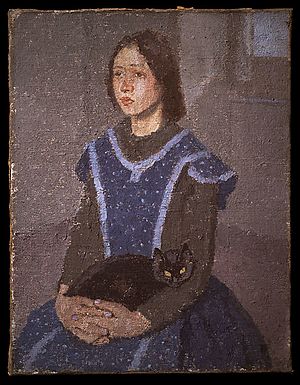
In 1916, Gwen John wrote that a painting should be finished in one or two sittings. To do this, she felt one might have to paint many canvases and discard some. Her surviving artwork is quite small. There are 158 known oil paintings, most of which are not very large. Most of her works are portraits. However, she also painted still lifes (arrangements of objects), interiors (rooms), and a few landscapes. She once wrote that painting a cat or a person was the same. She said it was about shapes and forms, and the subject itself wasn't the most important thing. Even though she lived in France for most of her adult life, her art always had a British feel.
Her early paintings, like Portrait of the Artist's Sister Winifred (around 1897–98), used thin layers of paint. This was a traditional way of painting. Later, with her series of paintings of Mère Poussepin (around 1913), her style changed. She used thicker paint applied in small, tile-like touches. She often painted the same subject many times. Her portraits usually show unknown women sitting, with their hands in their laps. One of her models said that Gwen would style her hair like her own. She would also have the model sit like her. The model felt Gwen's personality strongly while posing.
Gwen John made thousands of drawings. Besides her studio work, she sketched many women and children in church. Unlike her oil paintings of single women, these sketches often show people from behind and in groups. She also drew many sketches of her cats. She made only two etchings (a type of print) in 1910.
Her notebooks and letters contain many personal rules for observing nature and painting portraits. She even had a system of numbers for colors. The meaning of these notes is often unclear. However, they show Gwen's love for order. They also show the lasting influence of her teacher, Whistler, who taught that careful preparation was important.
Gwen John's art is quiet and uses subtle color combinations. This is very different from her brother Augustus's much brighter and bolder work. For a long time, Augustus was more famous. But now, many art critics believe Gwen was the more talented artist. Augustus himself once predicted this. He said, "In 50 years' time I will be known as the brother of Gwen John."
Legacy and Influence
Gwen John's paintings are kept in many public art collections. Some of the best examples can be seen at the National Museum Cardiff and Tate Britain in London.
A play called Still Lives by Candida Cave is about Gwen, Ida (Augustus John's wife), and Dorelia (Augustus John's mistress).
An art mystery novel, The Gwen John Sculpture by John Malcolm, features her time in Meudon, France. It also includes her relationship with Rodin.
An S4C documentary about Gwen John's life was presented by Ffion Hague. It showed the unveiling of a special plaque in her memory at Dieppe's Janval Cemetery in 2015.
Margaret Forster wrote a novel in 2006 called Keeping the World Away. It is centered around one of Gwen John's paintings, A Corner of the Artist's Room in Paris. The book starts with Gwen's own story. Then it follows the stories of fictional women who later owned the painting and how they reacted to it. The title comes from something Gwen John wrote: "Rules to Keep the World away: Do not listen to people (more than is necessary); Do not look at people (ditto); Have as little intercourse with people as possible; When you come into contact with people, talk as little a possible ..."
Gwen John was the aunt of the cellist Amaryllis Fleming. Amaryllis was her brother Augustus's daughter with another woman, Evelyn St. Croix Fleming. Evelyn's husband, Valentine Fleming, was a Member of Parliament who died in World War I. Through Amaryllis, Gwen John was a great-aunt to the actress Lucy Fleming.
Images for kids
-
Self-Portrait, probably 1907–1909, National Gallery of Art
-
The Nun, around 1915–1921, Glynn Vivian Art Gallery, Swansea
-
Girl Holding a Piece of Sewing, 1915-1925, Aberdeen Art Gallery
-
Ivy Leaves in a White Jug, 1920-1925, Aberdeen Art Gallery
See also
 In Spanish: Gwen John para niños
In Spanish: Gwen John para niños


